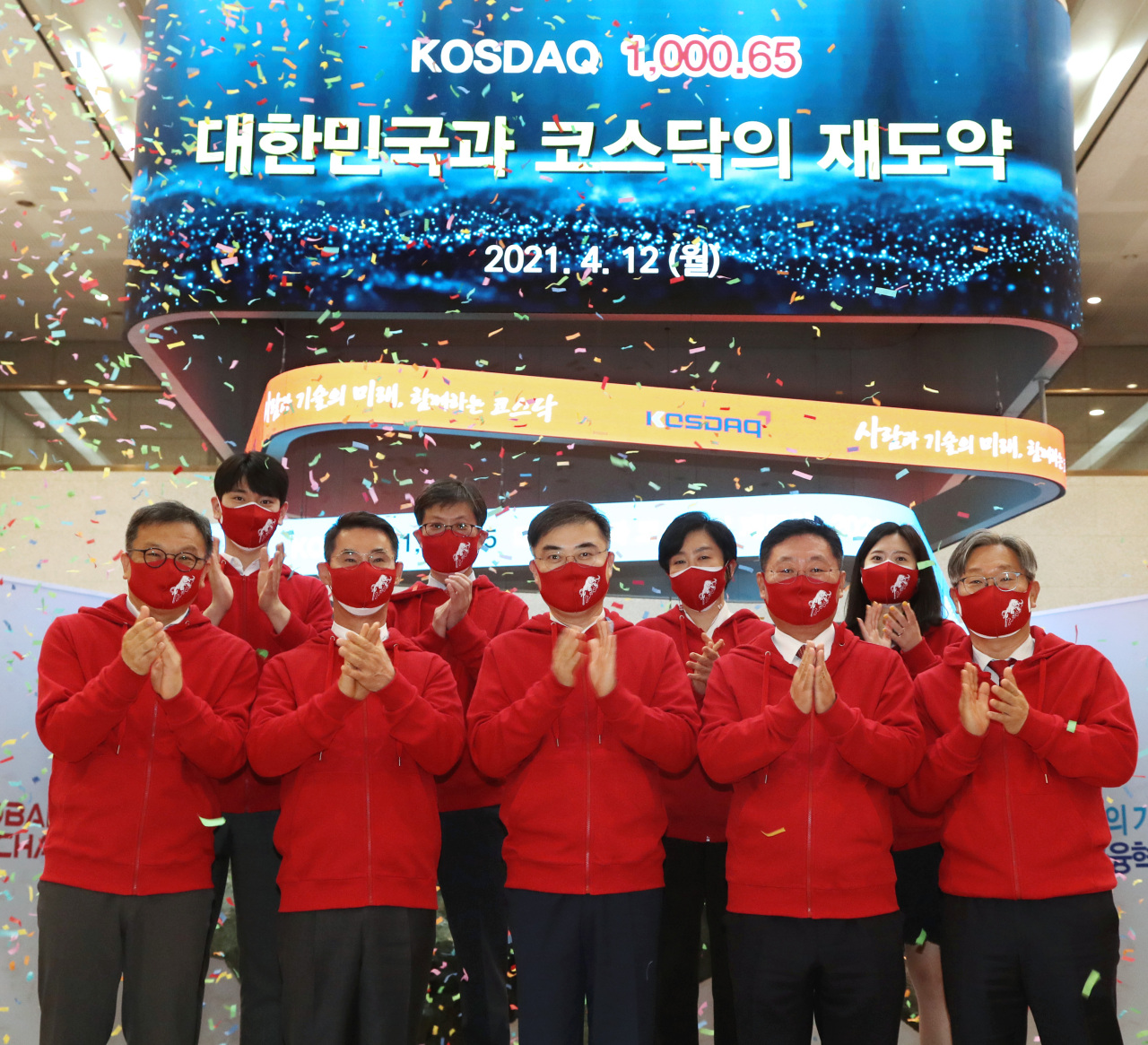 |
Kosdaq Listed Companies Association Chairman Chang Kyeong-ho (front row, second from left), Korea Exchange Chairman Sohn Byung-doo (front row, center), Korea Financial Investment Association Chairman Na Jae-chul (front row, fourth from left) and officials from the market operator celebrate South Korea’s tech-heavy Kosdaq’s closing above 1,000 points for the first time since Sept. 2000 at Korea Exchange’s Seoul office on Monday. (KRX) |
South Korea’s tech-heavy Kosdaq ended at a two-decade high on Monday, surpassing a 1,000-point threshold on rallies of secondary battery and bio shares.
The secondary index ended trading at 1,000.65 points, up 11.26 points or 1.14 percent, from the previous session’s close.
Both foreign and institutional investors purchased a net 36.2 billion won ($32.17 million) and 100 million won, respectively, while retail investors dumped 19.5 billion-won worth of shares.
Among the top 10 large-cap stocks, shares of EcoPro BM, a high-nickel cathode manufacturer and a close partner of SK Innovation, jumped 8.54 percent, on a weekend agreement between LG and SK that ended a two-year dispute over battery technologies. Local diagnostics company Seegene and SK Materials advanced 4.31 percent and 3.78 percent, respectively.
Other firms also edged up on Monday, including game company PearlAbyss (2.91 percent), Celltrion Pharm (1.6 percent), Celltrion Healthcare (1.48 percent) and Kakao Games (1.29 percent).
The Kosdaq index once neared the 3,000-point mark in March 2000 amid the worldwide dot-com bubble, but plummeted to the 500-point level in December the same year. In the meantime, the index briefly remained at the 1,000-point level in September 2000, but has never breached it since then. In 2008, under the impact of the global financial crisis, the index plunged to hover around 200 points.
Hit by the COVID-19 pandemic, the index nosedived to the 400-point mark in March last year. But fueled by strong bio and secondary battery sectors, it soared 158 percent from its yearly low of 428.35 points at the end of the same year. It again rose above the 1,000 point-mark during intraday trading on Jan. 27 this year, but ended below at market close.
Total market capitalization also closed at a fresh record-high of 411.1 trillion won, sharply up from 385.6 trillion won marked at the final trading session last year.
The Kosdaq market size came to 29 trillion won at the end of 2000. It ballooned to 98 trillion won after 10 years and drastically bulked up to 385.6 trillion won as of end-2020.
“Crossing the 1,000-point level in more than 20 years after the dot-com bubble reflects the improved quality of (Kosdaq) market that came along with listed firms’ business growth,” said a Korea Exchange official.
“Efforts made to activate initial public offerings of companies with high potential appear to have played a part too.”
Meanwhile, the main bourse Kospi rose 3.71 points, or 0.12 percent, to close at 3,135.59. Retail investors purchased a net 690.7 billion won, but foreign and institutional investors offloaded a net 327.7 billion won and 389.4 billion won, respectively.
By Jie Ye-eun (
yeeun@heraldcorp.com)








